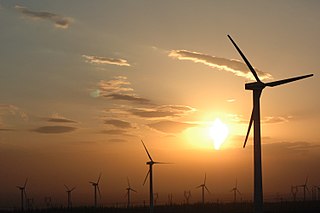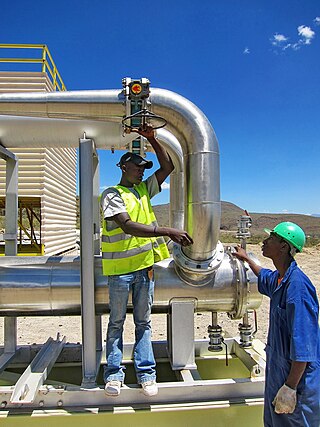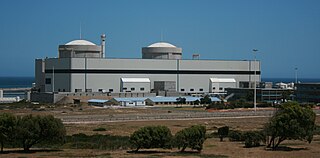The Integrated Resource Plan (IRP) is a plan aimed at estimating South Africa's electricity demand. It takes into account how the demand of electricity will be met and the expense of such a demand. [1] The plan refers to electricity generation and expansion programmes. In formulating the National Development Plan, the Department of Energy gazetted the Integrated Resource Plan 2010-2030 (IRP 2010) in March 2011; this forecasted the energy demand for the 20-year period. In October 2019, IRP 2019 was gazetted; this updates the energy forecast from 2019 to the year 2030. [2] [1]
The IRP was indicated to be a living document that would be revised and updated regularly. [3] An updated plan was released in 2019, after the first in IRP in 2011. [1] The stated objectives of the IRP are:
As of IRP 2019, 6 422 MW have been procured by the Renewable Energy Independent Power Producer Procurement Programme, of which 3 876 MW are in use on the country's electrical grid. [1] The following capacity has been commissioned as part of Eskom's build programme: 1 332 MW at Ingula Pumped Storage Scheme, 1 588 MW at Medupi, 800 MW at Kusile, and 100 MW at Sere Wind Farm. In total, 18 000 MW have been resourced as additional capacity. [1]

The Development Bank of Southern Africa (DBSA) is a development finance institution wholly owned by the Government of South Africa. The bank intends to "accelerate sustainable socio-economic development in the Southern African Development Community (SADC) by driving financial and non-financial investments in the social and economic infrastructure sectors".

Renewable energy in Scotland includes renewable electricity sources, solid biomass fuels, and biogas. Scotland's natural resource base for renewable energy is high by European, and even global standards, with the most important potential sources being wind, wave, and tide. Renewables generate almost all of Scotland's electricity, mostly from the country's wind power.

Renewable energy in Portugal was the source for 25.7% of total energy consumption in 2013. In 2014, 27% of Portugal's energy needs were supplied by renewable sources. In 2016, 28% of final energy consumption in Portugal came from renewable sources.

China is the world leader in wind power generation, with the largest installed capacity of any nation and continued rapid growth in new wind facilities. With its large land mass and long coastline, China has exceptional wind power resources: it is estimated China has about 2,380 gigawatts (GW) of exploitable capacity on land and 200GW on the sea. Wind power remained China's third-largest source of electricity at the end of 2021, accounting for 7.5% of total power generation.
Electricity in Pakistan is generated, transmitted, distributed, and retail supplied by two vertically integrated public sector companies, Water and Power Development Authority (WAPDA) responsible for the production of hydroelectricity and supplied to the consumers by the power distribution companies (DISCOS) under the Pakistan Electric Power Company (PEPCO). Currently, there are 11 distribution companies and one National Transmission And Dispatch Company (NTDC) all in the public sector, and the Karachi Electric (K-Electric) for the city of Karachi and its surrounding areas. There are around 42 independent power producers (IPPs) that contribute significantly in electricity generation in Pakistan.

Geothermal power is very cost-effective in the Great Rift Valley of Kenya, East Africa. As of 2023, Kenya has 891.8 MW of installed geothermal capacity. Kenya was the first African country to build geothermal energy sources. The Kenya Electricity Generating Company, which is 74% state-owned, has built several plants to exploit the Olkaria geothermal resource; Olkaria I, Olkaria II, Olkaria IV, Olkaria V, and Wellhead generation plants, with a third private plant Olkaria III. Additionally, a pilot wellhead plant of 2.5 MW has been commissioned at Eburru and two small scale plants have been built by the Oserian Development Company to power their rose farm facilities with a total of 4 MW.

India is world's 3rd largest consumer of electricity and world's 3rd largest renewable energy producer with 40% of energy capacity installed in the year 2022 coming from renewable sources. Ernst & Young's (EY) 2021 Renewable Energy Country Attractiveness Index (RECAI) ranked India 3rd behind USA and China. In FY2023-24, India is planning to issue 50 GW tenders for wind, solar and hybrid projects. India has committed for a goal of 500 GW renewable energy capacity by 2030.

As of 2019, renewable energy in Morocco covered 35% of the country’s electricity needs.
The electricity sector in Finland relies on nuclear power, renewable energy, cogeneration and electricity import from neighboring countries. Finland has the highest per-capita electricity consumption in the EU. Co-generation of heat and electricity for industry process heat and district heating is common. Finland is one of the last countries in the world still burning peat.
The term Smart Grid is most commonly defined as an electric grid that has been digitized to enable two way communication between producers and consumers. The objective of the Smart Grid is to update electricity infrastructure to include more advanced communication, control, and sensory technology with the hope of increasing communication between consumers and energy producers. The potential benefits from a Smart Grid include increased reliability, more efficient electricity use, better economics, and improved sustainability.

South Africa is the only country in Africa with a commercial nuclear power plant.
South Africa has a large energy sector, being the third-largest economy in Africa. The country consumed 227 TWh of electricity in 2018. The vast majority of South Africa's electricity was produced from coal, with the fuel responsible for 88% of production in 2017. South Africa is the 7th largest coal producer in the world. As of July 2018, South Africa had a coal power generation capacity of 39 gigawatts (GW). South Africa is the world's 14th largest emitter of greenhouse gases. South Africa is planning to shift away from coal in the electricity sector and the country produces the most solar and wind energy by terawatt-hours in Africa. The country aims to decommission 34 GW of coal-fired power capacity by 2050. It also aims to build at least 20 GW of renewable power generation capacity by 2030. South Africa aims to generate 77,834 megawatts (MW) of electricity by 2030, with new capacity coming significantly from renewable sources to meet emission reduction targets. Through its goals stated in the Integrated Resource Plan, it announced the Renewable Energy Independent Power Producer Procurement Programme, which aims to increase renewable power generation through private sector investment.

Solar power in South Africa includes photovoltaics (PV) as well as concentrated solar power (CSP). In 2016, South Africa had 1,329 MW of installed solar power capacity. Installed capacity is expected to reach 8,400 MW by 2030.

This article describes energy and electricity production, consumption, import and export in Kenya. Kenya's current effective installed electricity capacity is 2,651 megawatts (MW), with peak demand of 1,912 MW, as of November 2019. At that time, demand was rising at a calculated rate of 3.6 percent annually, given that peak demand was 1,770 MW, at the beginning of 2018. Electricity supply is mostly generated by renewable sources with the majority coming from geothermal power and hydroelectricity.
Despite its high potential for wind energy generation, wind power in Kenya currently contributes only about 16 percent of the country's total electrical power. However, its share in energy production is increasing. Kenya Vision 2030 aims to generate 2,036 MW of wind power by 2030. To accomplish this goal, Kenya is developing numerous wind power generation centers and continues to rely on the nation's three major wind farms: the Lake Turkana Wind Power Station, the Kipeto Wind Power Station, and the Ngong Hills Wind Farm. While these wind power stations are beneficial to help offset fossil fuel usage and increase overall energy supply reliability in Kenya, project developments have also negatively impacted some indigenous communities and the parts of the environment surrounding the wind farms.

Renewable energy in South Africa is energy generated in South Africa from renewable resources, those that naturally replenish themselves—such as sunlight, wind, tides, waves, rain, biomass, and geothermal heat. Renewable energy focuses on four core areas: electricity generation, air and water heating/cooling, transportation, and rural energy services. The energy sector in South Africa is an important component of global energy regimes due to the country's innovation and advances in renewable energy. South Africa's greenhouse gas (GHG) emissions is ranked as moderate and its per capita emission rate is higher than the global average. Energy demand within the country is expected to rise steadily and double by 2025.
As of 2021 there was little renewable energy in Belarus but a lot of potential. 7% of primary energy in Belarus was from renewables in 2019, mostly biofuels. As there is a lot of district heating more renewables could be integrated into that, but this is hindered by fossil fuel subsidies.

The Renewable Energy Independent Power Producer Procurement Programme (REIPPPP) is an initiative by the South African government aimed at increasing electricity capacity through private sector investment in solar photovoltaic and concentrated solar, onshore wind power, small hydro, landfill gas, biomass, and biogas. As of 2023, a total of 123 projects have been awarded to the private sector. Private sector investment totalling R256 billion has been committed to the REIPPPP. Four of the six Bid Windows have come online, totalling 6200 MW of installed capacity.